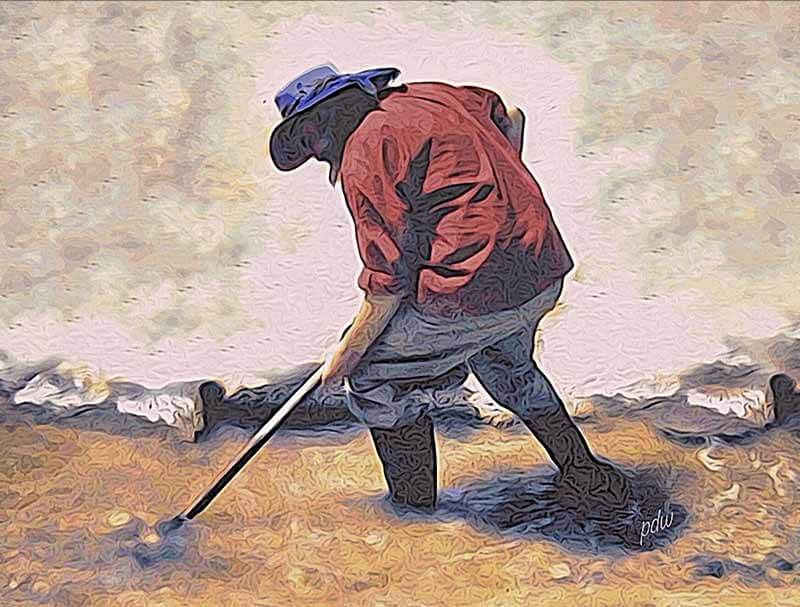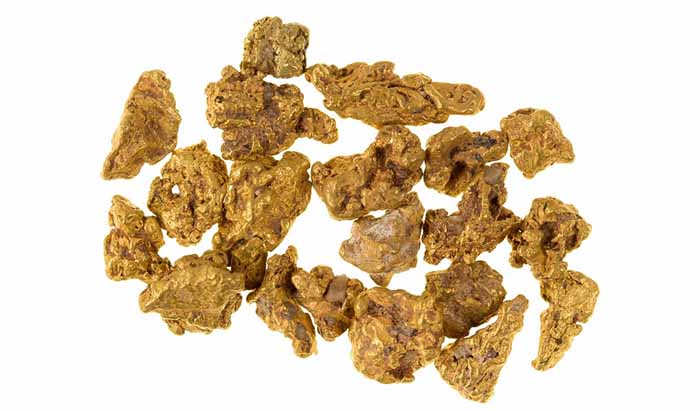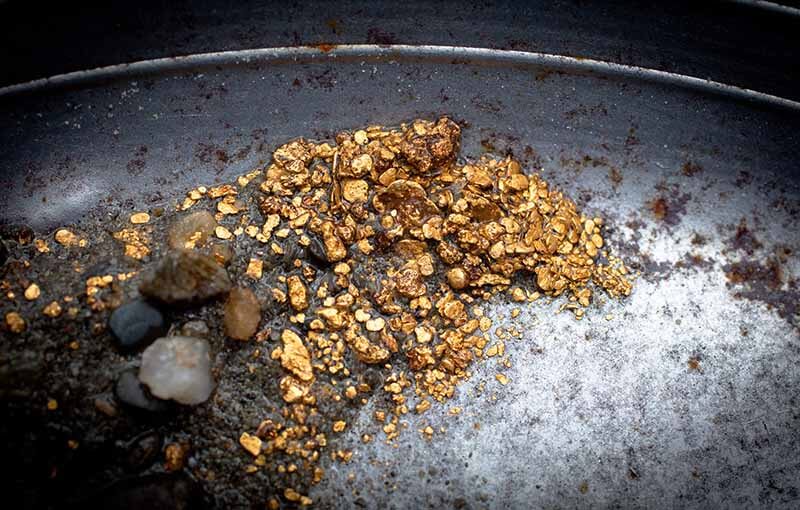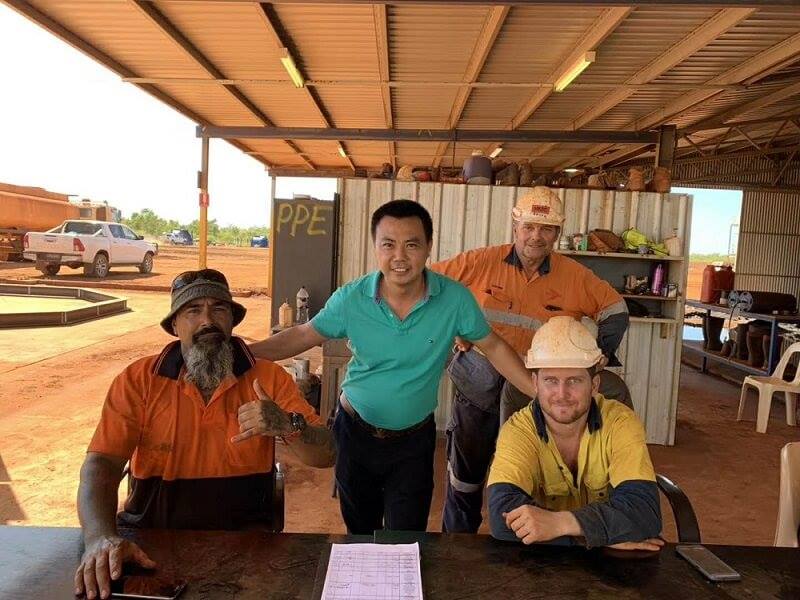Easily extracted gold ore has long been a major source of gold production in countries around the world, and such resources will be declining due to long-term mining.
In the paper, I list 5 Easily Extracted Gold Ores and 8 Processing Methods, let’s read on to find out!
What is Easily Extracted Gold?
1 Placer gold ore
Placer gold deposits are formed by primary gold deposits broken up by mechanical and chemical weathering and transported, sorted and deposited by external forces. There are many kinds of placer gold deposit, such as eluvial gold deposit, slope gold deposit, diluvial gold deposit, riverbed alluvial gold deposit and shore gold deposit, etc.
The characteristics of this kind of deposit are soft, shallow burial depth, generally 5~10m, some 20~30m; the thickness of gold-bearing deposit is generally 1~5m, individual up to 10m; The belt width is 50~300m on average, and the length can reach several kilometers or tens of kilometers; the slope of the gold deposit is very small, generally 0.002~0.02.
The gold ore is generally simple in composition, shape mostly in granular or scaly, and the particle size is usually 0.5~2mm, average density about 17.5~18.0g/cm3. According to the particle size, gold can be divided into a large piece of gold (greater than 5mm), coarse gold (5~1.65mm), medium gold (1.65~0.83mm), fine gold (0.83~0.42mm), extra fine gold (0.42~). 0.15mm) and the most particulate gold (or floating gold, less than 0.15mm).
2 Gold-bearing quartz vein ore
The basic composition of ore is quartz, with a content of more than 90%, and almost no heavy metal sulfide. Natural gold is mostly filled in the crack and cleavage surface of quartz in coarse grains, or disseminated in quartz veins in fine grains. Gold is easy to dissociate after crushing and grinding.
3. Gold-bearing quartz vein ore containing a small amount of sulfide
This ore is most common in gold-bearing quartz veins ore and generally contains 1% to 5% of metal sulfides. According to the state of gold production, it can be divided into two types: one is associated with sulphide ore, another is associated with gangue minerals such as quartz.
(1)Associate with sulphide ore
The composition of such ore is relatively simple. Pyrite is the main metal sulfide, and the content of sulfides such as copper, lead, zinc and antimony is very small. The relative content of natural gold in pyrite is more than 60%, and the remaining gold is present in gangue minerals such as quartz and other metal sulfides. This type of ore is most suitable for flotation. For the very fine gold contained in the flotation tailings, tailings cyanidation can be carried out. When the grinding product contains coarse particles of free gold, it should be added with mercury or gravity separation before flotation.
(2) Associate with gangue minerals
The main feature of this ore is that the metal sulfide content is low, and more than 70% of natural gold is symbiotic with quartz. The metal minerals in the ore are mainly pyrite. In addition, there is a small amount of chalcopyrite, pyrrhotite, stibnite, galena, etc., but no arsenic, antimony, clay and carbonaceous materials.
Such ores are more suitable for treatment by the “mercury + cyanide” method or the whole mud cyanidation method.
4 Quartz vein containing gold oxide ore
Oxidized ores are generally present in the shallower surface oxidation zone. According to the degree of oxidation, it can be divided into partially oxidized ore and oxidized ore. Most of the natural gold is found in gangue minerals and metal oxide minerals. The gold content of the ore is high, mostly between 10 and 20 gt. The surface of the gold particles often has an iron oxide film, and the degree of pollution increases with the increase of the oxidation rate of the ore. The commonly used processing method is “mercury (or gravity separation) and cyanide”, partially oxidized ore can use flotation process.
When the gold practices in the ore are coarse, the surface of the gold particles is clean, and the ore is not muddy, 70%~80% of the gold can be recovered from the ore by using the “single amalgamation” or “mixed mercury gravity separation” process.
When the ore with high oxidation degree, high content of mud, and series surface pollution, even though the particle size is coarse, it is not suitable to be directly treated by amalgamation. It must be gravity separated first, and the heavy sand (concentrate) is selected to be scrubbed by grinding machine to remove the surface contamination, then mix the mercury.
The fine particle ore with a low oxidation degree is usually treated by flotation.
As for the fine particle ore with high oxidation degree, and dispersed in non-sulfide minerals, even if the surface of the gold particles is not contaminated, the gold particles are too fine to be treated by the amalgam method. The only feasible treatment method is the whole mud cyanidation process, the gold leaching rate can reach 96%~98%.
5 Pyrite gold-bearing quartz vein ore
The mineral composition of this type of ore is similar to that of a small amount of sulfide quartz vein ore. The difference is that the sulfide content is high (5% to 15%). Metal minerals include pyrite, pyrrhotite, galena, sphalerite, chalcopyrite, and porphyrite, but pyrite accounts for more than 80%. The gangue minerals are mainly quartz, followed by calcite, feldspar, chlorite, sericite and the like.
Natural gold has a very close relationship with pyrite, so this type of ore is very suitable for flotation treatment, and the recovery rate can reach 93%~96%. If the ore contains coarse particles of free gold, it should be gravity separation before the flotation. When there are refractory gold-containing sulfide mineral particles in the flotation tailings, they can be recovered by the gold shaker.
8 Methods to Extract Gold
The gold beneficiation process of easy to separate gold ore consists of amalgamation, gravity separation, flotation, and cyanide. The choice of the extraction processing method depends on the nature of the ore and the requirements of the product form.
The commonly used beneficiation flow as following.
You may interest in gold processing solutions, get to know in different gold mine conditions and requirements, what gold processing machines used, and how the gold washing plant configuration.
1 Amalgamation
This procedure is suitable for the quartz primary ore and oxidized ore containing coarse gold. Simple layout, low investment, and fast effect, which is suitable for small gold processing plant.
related post: Gold Extraction Processing and Environment Consideration
2 Amalgamation – gravity separation
Two schemes: first amalgamation and then gravity separation or first gravity separation and then amalgamation. The former one is suited for the treatment of simple gold-bearing quartz vein sulphide ore, amalgamation process can recover the coarse particle-free gold, then gravity separation to select the heavy metal sulfide concentrate containing gold. The latter scheme, first gravity separation and then amalgamation, is suited for those oxidized coarse particle ore, and placer gold ore which with a low grade.
3 Gravity separation ( or amalgamation) – cyanide process
This flow design for gold-bearing quartz vein oxidized ores.
How to choose gold processing gravity separator? gold shaker table, centrifugal concentrator, spiral chute. Engineer online to help.
4 Flotation separation
the flotation process is commonly used to process the gold-bearing quartz vein ore which contains fine particle gold and good flotability sulfide ore, and process gold sulfide ore which contains several valuable metals (such as copper, lead, zinc). The flotation process can enrich gold and other valuable metals to the maximum extent, and waste tailings can be obtained with low production cost.
5 Mercury – flotation combined process
The basic premise of using this process is that the coarse gold in the ore can be recovered by amalgamation. the great feature of this process is that can achieve a higher recovery rate than a single flotation process. In addition to the ore processed by the above flotation process, gold-bearing oxidized ore and ore associated with free gold are suitable.
6 Cyanidation (full mud cyanidation) process
As for such gold ore, in the presence of a fine particle in quartz gangue minerals, which are deeply oxidized and do not contain Cu, As, Sb, Bi and carbonaceous materials, is suited for adopts cyanidation.
Advantages: low cyanide consumption, high leaching rate, high efficiency and easy control.
7 Flotation – cyanide process
This combination is mainly used to process gold-bearing quartz vein ore and quartz-pyrite ore those have close symbiosis relation of sulfide. Compared with the cyanidation process, the flotation – cyanide process has the advantages as following:
does not require a fine ground particle, saving consumption; lesser washing and mixing step; smaller area required, low investment.
8 Flotation – gravity separation
It is mainly based on flotation, and is suitable for the ore that is closely symbiotic with GOL and sulfide, and can only be recovered by smelting. Due to the small amount of non-floating sulphide ore particles (mostly pyrrhotite) in the flotation tailings, it needs to be recovered by using a gold shaker table, spiral chute and cyclone.
In summary, the choice of gold processing flow is closely related to the nature of the ore. For some complex gold-bearing ores, especially refractory polymetallic gold-bearing ores, it is technically necessary to select or develop a combination of the gold processing methods in order to maximize gold recovery and efficiently recover various useful ingredients.
Gold processing equipment for sale
If you have questions in flowsheet design, mining machine configuration, gold plant optimization, gold processing techniques support and the like, we are here to help, just say “Hi” to us!
JXSC, a 35 years gold mining machine manufacturer, has been supplying effective and safety gold mining equipment for hundreds of gold mining companies around the world, Australia, USA (like California, Colorado, Georgia, Alaska), India, Congo, South Africa, Ghana, Tanzania, Ghana, and so on.
LATEST PRODUCTS
Twin Screw Feeder
【Feeding Capacity】 10-160 t/h【Power】 2.2-…
Tubular Screw Conveyor
【Capacity】6-50 m3/h【Procesible Material】 …
Heavy Plate Feeder
Capacity: 100-240 m3/h Power: 15-45 kW Speed: 0…














